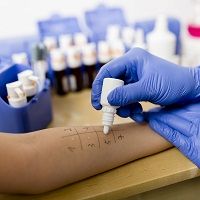Article
Appropriate Recognition and Management of Anaphylaxis
Author(s):
To ensure that anaphylaxis episodes are treated in a timely and effective manner, action plans should be developed and distributed to patients, family and other caregivers, and schools.

The prevalence of anaphylaxis in the United States has recently been estimated to be 1.6% (and some research suggests that the percentage is probably higher). The most common triggers are medications (eg, antibiotics; 34%), foodstuffs (31%), and insect stings/bites (20%).
At the 2014 AAP National Conference & Exhibition in San Diego, CA, Mitchell R. Lester, MD, FAAP, Fairfield County Allergy, Asthma and Immunology Associates, Norwalk, CT, covered the clinical description and recognition of anaphylaxis, identification of the most common causes of anaphylaxis, the importance of rapid diagnosis and treatment of anaphylaxis, and the treatment of choice for anaphylaxis and its rationale.
He described anaphylaxis as an acute, multi-system reaction caused by a rapid release of mediators from tissue mast cells and peripheral blood basophils. Immunologic mechanisms can be allergic (IgE-mediated) or non-IgE-mediated. Non-immunologic anaphylactic reactions also occur. A third category is idiopathic anaphylaxis.
The clinical manifestations of anaphylaxis are the acute onset of a reaction involving skin and/or mucosal tissue AND either respiratory compromise, hypotension, OR symptoms of end organ dysfunction. An alternative scenario is two or more of the above symptoms and/or persistent gastrointestinal (GI) symptoms occurring rapidly after exposure to a likely allergen. A third scenario is reduced blood pressure after exposure to a known allergen.
In children with anaphylaxis, the frequencies of symptoms are 90% skin, 70% respiratory, and 50% GI. Less than 10% of these patients go into shock. The causes of anaphylaxis in childhood are, in order of frequency, food-induced, drug-induced, food-associated, exercise-induced, venom, “other,” and idiopathic. The first four are common triggers of IgE-mediated anaphylaxis. Common non-IgE-mediated instigators of anaphylaxis include radiocontrast media, various medications (narcotics, NSAIDs, ACE inhibitors, etc), sulfiting agents, exercise alone and idiopathic and other causes.
Factors affecting prognosis include time of onset, delay in initiation of treatment, route of exposure, use of β-blockers, and any underlying disease. Temporal patterns of anaphylaxis are uniphasic, biphasic, protracted, and delayed.
Lester said taking the patient’s history is the main tool in diagnosis and management; it is critical to identify the single trigger. The timing of exposure (if known) and the sequence of symptoms are also important. Laboratory tests such as specific IgE or complement activation are useful to confirm or refute a diagnostic suspicion but are not diagnostic. A positive allergen test indicates sensitization not necessarily allergy. Allergy requires sensitization plus mast cell activation with exposure. He strongly cautioned against testing for multiple allergens (panel testing). A patient may be sensitized to a range of allergens, most or all of which may be irrelevant to the anaphylactic reaction. In vivo skin tests are preferable to in vitro immunologic tests (eg, ImmunoCAP), but the former may not be feasible in a community practice.
There is a place for testing for mast cell mediators in anaphylaxis but the timing is crucial. Plasma histamine peaks within minutes while serum tryptase peaks after about an hour. Tryptase is less sensitive than histamine although fairly specific.
Lester said that there is only one answer as to the treatment of choice: Just give epinephrine. The onset of action for intramuscular epinephrine is seconds compared to minutes for antihistamines (by any route) and hours for corticosteroids. Speed is so critical that Lester has re-ordered the traditional CABDEF acronym for the elements of management of anaphylaxis to the following sequence: Epinephrine/Circulation/Airway/Breathing/Fluids/Defibrillation.
Secondary measures include additional epinephrine administration, diphenhydramine or other H1-blocker, ranitidine or other H2-antagonist, albuterol nebulized solution, and methylprednisolone.
To ensure that anaphylaxis episodes are treated in a timely and effective manner, Lester strongly recommends that action plans be developed, printed and distributed to patients, family, other caregivers and schools and also for the physician’s office. The office staff should participate in allergy emergency drills with pre-assigned roles.
Lester summarized the main messages of his talk as follows:
- Trigger identification — history and testing
- Patient education — anaphylaxis in general, trigger avoidance, epinephrine auto-injector for emergencies
- Detailed action plan





